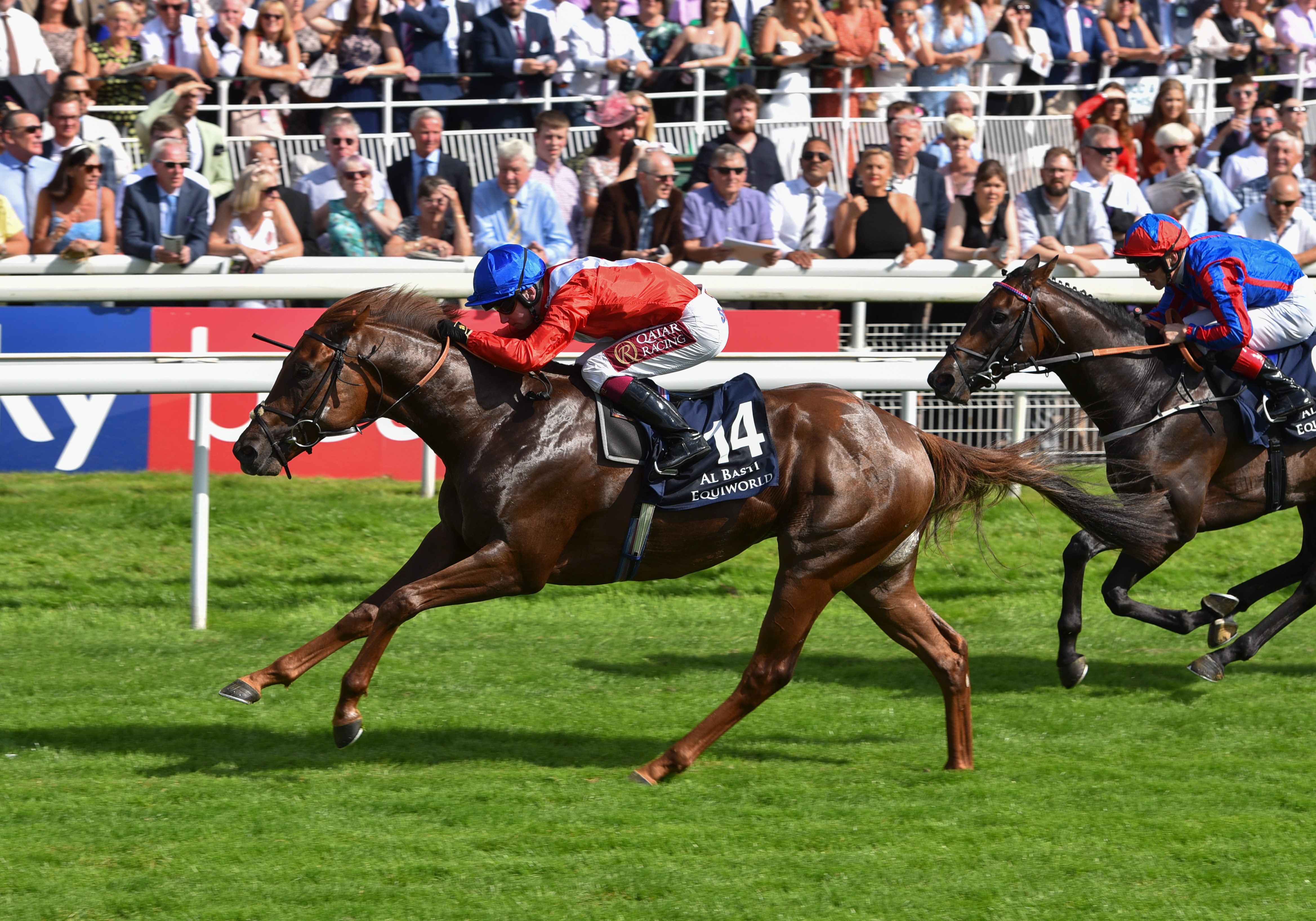THE 249th GIMCRACK DINNER

On Tuesday 10 December, the 249th Gimcrack Dinner was staged at York Racecourse.
According to tradition, the event is addressed by the owner of the horse which wins the £225,000 Gimcrack Stakes, the richest Group Two for two year-olds colts only in Britain, sponsored by Al Basti Equiworld-Dubai, at the Welcome to Yorkshire Ebor Festival in August.
In 2019, the Toast to British Racing was made at the conclsuion of a speech by Chris Richardson, on behalf of the winning owner in the race, Cheveley Park Stud.
Their colt, Threat, won this year's Al Basti Equiworld Gimcrack Stakes. Trained by Richard Hannon and ridden by the 2019 Champion Jockey, Oisin Murphy.
The response to the Toast was given by Annamarie Phelps, Chair of the British Racing Authority.
The text of both main Toasts is set out below:
249th GIMCRACK DINNER - SPEECH ON BEHALF OF CHEVELEY PARK STUD
On behalf of David and Patricia Thompson, owners of Cheveley Park Stud, it is a great honour to address you this evening.
We have to go back 44 years, to 1975, to find the last time the famous red, white and blue colours of Cheveley Park Stud were carried to victory in this most prestigious of two-year-old races. It was in 1973, that a chesnut colt by Jukebox out of Veronique, was born and offered as a yearling by his Yorkshire breeder Ruth Cookson, at the then Doncaster Sale. Bought for 2,000 Guineas, he was later named Music Boy. Trained here in Yorkshire by Snowy Wainwright, Music Boy went on to win the Windsor Castle, before winning the Gimcrack. Such was the excitement created by this victory that the Thompsons’ decided to buy Cheveley Park Stud and stand Music Boy at stud. The rest is history.
Since then the Thompsons’ dedication, contribution and commitment to the thoroughbred industry has been immense. They have grown their bloodstock interests from a broodmare band of 28 to just over 140 today, plus the facilities to stand up to 8 stallions in the famous Isinglass Stallion Yard. Built to accommodate the Triple Crown winner, by his owner breeder Harry McCalmont in 1897, Isinglass had won 11 of his 12 races. His earnings were only to be surpassed by Tulyar in 1952. The property has now expanded to just under 1,000 acres, still admittedly far below the 7,800 acres as it was, back in the 19th century.
When I joined the stud back in 1987, Mrs Thompson said “we have great plans for the stud, a property steeped in history and we feel honoured to be the custodians of such a beautiful estate”.
Aside from the stud and their significant flat interests, now numbering around 120 horses in training, their National Hunt interests have also been significant over the years. Many here may remember Party Politics, winning the 1992 Grand National in Patricia Thompson’s colours, only five days before the General Election – an election that, once again, reminded us of the unpredictability of politics by confounding both bookmakers and pollsters.
Success at the Cheltenham Festival Meeting this past spring set the stage for another interesting and adventurous year and reaffirmed the Thompson family’s broad involvement in all aspects of the industry, not only in England, but in Ireland too.
Whilst the Thompson family very much appreciate all that the thoroughbred industry has allowed them to develop, enjoy and embrace at every level, they also note that times have changed.
The industry as a whole needs to appreciate the significant contribution which the Thompsons, in common with all owners at every level, make to the thoroughbred industry. Without their immense contribution, the racing and breeding industry simply would not exist.
Of course, in any sphere, there has to be a balance between risk and reward and whilst it would be pointless to suggest that owners should enjoy their racing for free, it seems to us that this balance has been out of kilter for a long time and that the position is becoming steadily worse.
It is a decline that cannot be allowed to continue.
It is largely thanks to the investment of the bigger owners that we have all enjoyed, over the last half century, a golden age for the thoroughbred however, we believe that the next half century is likely to be different in many ways.
Is British racing ready for these new challenges and will it be ready to exploit opportunities that may emerge too?
Where is the next generation of owners to come from?
Without them, breeders will have no market; and that market needs to extend far beyond the elite. So, in trying to create a future which aims to extend a fascination with the racing and breeding to a wider public, both as spectators and hopefully as participants as well, we need to remember what our sport is all about.
There can be rather more to a day’s racing than lunch, a quick visit to the paddock, the bookies and - at last - the bar! Perhaps we try too hard to simplify racing for the casual racegoer when we should be encouraging a greater degree of immersion. It is possible for the casual spectator to develop a deep and passionate interest that lasts a lifetime.
The enthusiastic and knowledgeable crowds, who attend this great racecourse are witness to this and they are the successors of the 30,000 that came to Newmarket’s July Course in an era of wartime petrol rationing to witness the 1945 Derby triumph of Dante, one of the greatest horses ever bred and of course trained here in Yorkshire. No marketing initiative brought them there and they stand as a reminder of the fascination that a great racehorse has for committed British racegoers. That of course still holds true today but I can’t help but feel that too many of today’s racegoers remain unaware of the subtleties, complexities and fascinations of our wonderful sport.
We cannot underestimate the challenges that lie ahead, or the competition our sport faces in a world of 24-hour entertainment, for premium leisure time and short attention spans; but we need to remember that the thoroughbred and its future must be at the heart of what we do and the key to the future of our sport. Dumbing down is not the answer.
We really can attract a new audience in very different times to those we have been lucky enough to enjoy but we are in danger of putting any number of carts before the horse.
It seems to us that the biggest problem facing British racing today remains a lack of unity. The racing ‘product’ is dependent upon different interest groups, in many cases with understandable but often conflicting responsibilities to shareholders and others who have no close connection to, or passion for racing; commercial pressures dictate a short-term view amongst many participants that does not sit comfortably with our role as the present custodians of the thoroughbred racehorse, a creature fashioned by man over two and a half centuries and now, to a sadly increasing number of ‘stakeholders’, a commodity bred to serve a swollen betting market that has seen the fixture list grow commensurately.
The cricketing legend, Michael Holding, perhaps understands much more about racing than I understand about that similarly subtle entertainment, cricket, was once quoted as saying: “You can’t change racing, you can just have less of it and make people more welcome.” Middle stump.
Fortunately, there still remains a core of participants in the industry with a common goal and if we place the thoroughbred and its future at the heart of an industry-wide recovery plan, the next half century may begin to look rosier than perhaps it does now. A vibrant, united industry, growing on the rewards of its own income streams, not selling itself too cheaply to outside interests, will benefit all its participants. The unity needs to start now.
To recite a litany of what is wrong with British racing would be neither constructive nor original. It would only serve to mask the positive work being done by so many and progress that has been made; but there are areas that we should like to highlight.
Why is British racing still dependent upon a cut from the gambling activities of others? Do we recognise that racing thoroughbreds constitutes one of the best
sporting betting mediums on the planet and that in this country, which has arguably the best racing in the world, we in fact run it for other people, who tell us what they want?
Do we truly consider the impact that this has had on all participants through a fixture list that is so focussed on maximising betting turnover?
Are we seriously thinking about the consequences of sending huge books of mares to the most popular stallions? This is a different type of climate change, which we feel will alter and potentially harm the gene pool in the future, for which the next generation will certainly not thank us. The initiative of the US Jockey Club to propose restrictions in stallion book sizes can only be a welcome contribution to what should be an international industry-wide debate.
Why are so many British breeders attracted by breeding schemes based abroad? This is a factor which should set alarm bells ringing and perhaps switch on the odd lightbulb as well.
Since I joined Cheveley Park Stud in 1987 I have seen the dramatic and hugely worrying demise of the smaller breeder, which has to stop now, as if we have no breeders, we will have no racing.
What can be done to reverse this, I ask you?
What can be done to make British sale rings a fairer and more transparent market place?
The industry initiative in this direction is to be welcomed unreservedly but let us not throw out the baby with the bathwater.
This year, we have seen the equine markets shored up, once again, by the hugely important contribution from the Maktoum Family, something we cannot take for granted, but which is hugely appreciated by us all within the industry. Overseas support of our markets has also been most welcome and essential.
What can be done to improve retirement/retraining of racehorses?
Too many ‘pensioned’ racehorses are a serious knock-on effect due to the over production that is encouraged to satisfy the race programme. This is of the greatest concern and must continue to be addressed at the highest level.
The sports future may depend on finding the solutions.
Can we cheer up race cards for the benefit not just of racegoers but the industry as a whole?
Many racecourses now provide excellent, relevant and entertaining information on the day’s racing and its participants but too often the race programme itself is dispiriting and homogenous.
Sales races have for many years introduced something different and positive for the industry and we have had, innovative races for instance for grey horses only.
Great fun and to be encouraged, but why not try, for example:
A well-endowed series of maiden races in the second half of the season for two year olds sired by stallions that have won over a mile and a half or further. This
should help the staying thoroughbred below Group level and encourage stud farms to invest in, and stand, middle distance stallions for breeding on the flat.
A claiming race on every race card (I realise that I may be pushing my luck here) to supplement the endless diet of poor handicaps and to provide new opportunities for owners and trainers and add some spice for spectators.
Or, more lower value auction races, to help smaller owners to be competitive against horses which cost large sums as yearlings?
There is no doubt scope for many other ideas but how often do we hear them?
Whilst commending the progress that has been made, what more can we do for the backbone of this industry our stud and stable staff? They work long, unsocial hours and their reward, for their dedication, is working with the thoroughbred.
Fine words, however true, but such fine words, butter few parsnips.
Bodies such as Racing Welfare and the wonderful facilities they and others provide around the country are, an important and essential part of the support mechanism. Staffing needs further significant investment and support to encourage recruitment. From employment opportunities, to the managing of personal issues and the challenges that people of all ages face in all walks of life.
We embrace opportunities for people everywhere to get involved and to experience what racing and breeding offers as a profession, through the likes of the National Stud courses. The Godolphin Awards are a wonderful initiative, but we need an industry to be there for these people in the future.
I want this evening to stress the positives. We are all so lucky to be involved, in whatever way, with the racing and breeding of the thoroughbred. It is that which should unite us. It is this too that must encourage us to steer a course for the future that is self-determining.
A course that must be receptive and resilient to changing circumstances.
Finally, I now see on my notes the word TOAST.
I hope that this is not a reflection of my condition at the end of this extended ten minutes!
In conclusion, I should like to thank you for listening, to thank, on behalf of Mr. and Mrs. Thompson, THREAT’s trainer Richard Hannon, all his staff in Wiltshire, our jockey at York, Oisin Murphy, also of course, a special thank you to Al Basti Equiworld Dubai, for sponsoring this historic race and finally the York Race Committee who, along with William Derby and his team, run this historic and magnificent racecourse with such flair and professionalism.
249th GIMCRACK DINNER - SPEECH BY ANNAMARIE PHELPS
My Lords, Ladies & Gentlemen; Thank you Lord Grimthorpe ‐ Teddy if I may ‐ for that introduction and for the honour of replying to the Toast on behalf of British racing.
My congratulations to Cheveley Park, to Richard Hannon, Oisin Murphy and the team behind Threat’s success in the Gimcrack Stakes.
I’m proud to be asked to speak at this finest of racecourses, a jewel in the crown of British racing, in celebration of a horse who competed four centuries ago.
If anyone needed reminding of racing’s traditions, its special place in our national life, this is the place to be.
I am very proud to be here with so many legends of British racing. Well done, Mark Johnston, for setting a new record for winners in a single year and great to see the previous holders of the flat record Richard Fahey and Richard Hannon are both with us.
I remember well when Yorkshire finished 12th in the Olympic Medals table in 2012 – courtesy of the Brownlee brothers, Jessica Ennis and others – and I’m delighted to find your dominance extends to British racing too. Just don’t tell anyone in Newmarket I said that.
There’s nothing I can tell this audience you don’t know already about racing. I’m still working on being able to recite the full list of Derby winners since the war – the first of which, of course, was Dante, trained by Matt Peacock in Middleham. Don’t need to go on really, do I?
What I have seen over the last six months is a community united by a love of seeing horses race. I’ve seen the care taken in stables and on racecourses, amazing facilities at veterinary clinics and equine
hospitals, the exuberant joy with which horses young and old compete and the fulfilling and purposeful lives they lead.
I have seen the power of racing at its best; welcoming, open, uniting families and communities through a love of horses and a love of tradition, racing takes care of its people; and on every course, in every yard, at every stables, takes responsibility for our horses.
That’s what you all do everyday of the year and I am genuinely in awe of the physical and mental commitment you all make, of the complexity and relentlessness of your businesses and the total dedication shown by you and your families day-in, day-out.
In return, it’s up to the BHA to work with the Racecourse Association, The Horsemen’s Group and all their constituent members to ensure that the sport you love stays in good health. We want a sustainable and prosperous future, to be relevant in modern Britain, understood and accepted as an integral part of our sporting and national culture.
I don’t need to tell you that now, more than ever, racing needs to be open to change and adapt to stay relevant. This is a global sport and we are subject to the same competition that all leisure pursuits and sports are.
If we want to move forward, we need to act on issues that we see as risks and threats and be proactive in addressing opportunities.
John Gosden put it very succinctly recently when he said that “now is not the time to assume the status quo is secure”.
When Sir Hugh Robertson spoke last year, he focused on how racing is run and identified 5 critical factors required for success. I’ll pick out just the first two.
Number one was to ensure that racing’s key stakeholders (BHA, RCA and Horsemen) have agreed roles and responsibilities.
Much time has been spent discussing this over the past 18 months. The BHA’s Board has changed with an increased number of directors nominated by our members – horsemen and racecourses - and fewer independents.
My priorities are to ensure we have a robust structure for you as stakeholders to be heard and kept informed through your respective associations; and to ensure racing’s tripartite structures can work together effectively to make the right decisions for the sport. I hope we are nearing agreement on what this looks like but there is still work to do.
Hugh’s second challenge was to agree a long-term strategy. We need a healthy and sustainable sport providing good employment for staff, that looks after its people and is resilient to fluctuations in Levy funding.
Good work is being done, led by the Chief Executive of the RCA, David Armstrong, to set out how racing’s commercial model is working so the sport can agree how to grow revenues.
You may be a trainer wanting to see higher prize money (I haven’t yet met one who has asked for lower prize money). You may be running a racecourse and want to optimise your revenues from media rights, betting and customers. Either way, you all have a stake in the success of this project. But we can’t just focus on the level of prize money.
You want good decisions from us. We want to make well-considered decisions, based on the analysis of accurate data, to achieve the best possible outcomes for your businesses and the sport. So please support this work.
The BHA has no magic wand. Without a shared understanding of the economic situation across the sport, the BHA can’t guess at the impact its decisions on fixtures will make. The money coming into racing will only increase if all three parts of the sport work together.
So as the plan takes shape, how do we tell articulate our story to keep public confidence and attract more revenue?
We know racing doesn’t have the level of interest amongst the public we’d like. More people are interested in boxing and golf [though marginal]. More than twice as many say they’re interested in tennis.
It makes it harder to attract sponsors and advertisers, it diminishes the value of our broadcast rights, it makes it harder to get people to race-days or to invest as owners.
If we’re less popular, fewer people will rally to our side when we come under fire. The research data tells us we need to focus on our relevance, striking the right balance between our proud traditions and looking and feeling like the modern, diverse audience we need to attract.
It also matters that racing is understood and accepted, especially when it comes to the participation of animals in sport.
You know that horses’ lives are enriched through racing, that the benefits to them of a purposeful, meaningful existence with excellent standards of care, outweigh the risks. You know we do what we can to minimise those risks we can reasonably avoid.
But when we asked the public and committed racegoers, in support of our horse welfare strategy, too many are not convinced. Perhaps the good news is that a large majority don’t have a view at all - so we do have an opportunity to convert these to supporters.
How? Well, we’ve canvassed views across the sport and you won’t be surprised to hear that you and the rest of racing’s family want horseracing and horses to be at the centre of national life,
celebrated as champions and companions. You believe in the power of racing to excite & inspire, to offer a social occasion like no other, to bring families and people together, whatever their background.
I’m delighted that Richard Philips and the NTF are looking at
the idea of a national racehorse day to help the sport achieve this. With the RCA, and Great British Racing, we’ve offered our support.
The new Horse Welfare Board will publish its industry strategy in the New Year. Without wanting to preempt it, I know it will show racing to be leading, not reacting to the conversation about the participation of horses in sport.
It will demonstrate the good work you’re already doing across the industry. It will also map out our ambition to get even better. I’m sure it will challenge all of us, including the BHA. But if we were all entirely comfortable with it, we wouldn’t be pushing ourselves hard enough.
If we want to change people’s attitudes and win over those who are neutral about racing – at the very least ensure they are not won over by our critics, we need to be doing something different. But doing different is not always comfortable or easy.
This is an opportunity to get on the front foot - demonstrating that the power of racing is matched by the responsibility we take for our horses.
So I hope anything we say publicly will make people feel positive about racing. I want people to be coming to racing for the first time and to be so excited by what they see that they are natural advocates for it.
We all have a part to play. Some of us focus on government, some talk to the customers who turn up on raceday for a great family day-out, some appear in the media talking brilliantly about the horse they prepared for victory or the ride they’ve ridden: our trainers and jockeys in particular have an enormous public-facing opportunity to talk in a truly authentic way about how important our horses are to us.
We won’t get a better opportunity than the Grand National this year, if Tiger Roll goes for a hat-trick. I look forward to a huge effort to make the most of that mainstream media attention. Let me just check how those negotiations on his handicap mark are going…
A final thought then. What should the BHA be contributing to the health and prosperity of the sport and where do we fit into the plan?
Let me tell you how I think it looks from outside the sport.
First, the sport’s right to regulate itself on horse welfare has been challenged by two of the main UK parties in this election ‐ with one focused on the issue of the whip.
Whoever wins or loses, this challenge isn’t going away.
If racing wants to retain self‐regulation, it will need to show, in my view, greater external scrutiny of horse welfare standards.
If racing doesn’t ensure this, it may be forced upon us.
I believe the horse welfare strategy will show the BHA as regulator, and our industry have adopted a more collaborative approach.
It’s a delicate balance to strike but the BHA is well-respected in government and across sport integrity circles [I would not be here if I genuinely didn’t believe that].
As well as being the independent regulator, the BHA also leads engagement with government, answering to and collaborating with, a public affairs group of industry representatives.
I know that racing has a strong and effective approach dealing with government. I’ve seen other sports. Few are as well organised.
But we can’t expect lobbying alone to win the day. You will have seen what a prominent role animal welfare has taken in this election campaign. It’s popular with voters, especially activists. We need to build up positive support in an equally active way amongst the public, equipping people with the information they need to have confidence in the welfare provided to our horses.
Public sentiment on issues like animal welfare and gambling ultimately drives government decisions.
With gambling increasingly defined by politicians as a public health issue, we need to make sure that our commitment to social responsibility is clear, visible and consistent.
Our focus early next year will undoubtedly be to identify new supporters from the 150 plus new MPs we expect to see, and ensure our voice is heard on everything from Brexit to betting.
What about our role as regulator? Well, I have no doubt that sport benefits most when regulation is smart: fair, transparent, appropriate and pragmatic. Burdens must be justified by beneficial impacts and alternatives considered before new regulations are introduced.
The BHA needs to target its precious resource to deter and catch those who set out to cheat the system, to ensure fair play for all: owners, jockeys and trainers, bookmakers and spectators; so that continues to be admired for its integrity; and remains a sport that people want to work in and businesses want to invest in, to sponsor and be proud to be associated with.
We are open to change in how we regulate, provided the desired outcomes are achieved.
In some areas, though, we do need to look at what we regulate. Some want more regulation on syndicates, to give investors greater assurance about their financial probity.
Some want us to be more involved in protecting buyers at the sales [an area we don’t cover presently]. Mind you, some of you don’t believe it is necessary at all. Which ever side of the fence you sit on, we will publish the review we did of the buying and selling of horses before Christmas.
Our Board will decide whether we play a role in providing assurance to buyers at the sales when we see what actions the Bloodstock Industry Forum is proposing to take. The onus must now be on the Forum to decide if it wants the BHA involved in maintaining the confidence of their customers. We’re ready to assist.
I would like to make two last points. First, I’ve been hugely impressed by the professionalism and commitment shown by my new BHA colleagues. Each of them loves horse racing. They are as passionate as any racing fans. Nick leads from the front and calls it as it is. He and his team are here to serve the sport and to protect it. They worry about tomorrow so you can enjoy today.
Second, I’m seeing more regular consultation and a new spirit of collaboration between the BHA and those it regulates. We’ve
listened to your views on how we consult on the decisions we take and will be making changes in 2020. Of course, you won’t always like the outcomes, but we are committed to doing things differently.
Now really is the time for unity, not division. We need leaders who can work together, cooperate and sometimes compromise. The BHA must be collaborative to the core, a role‐model for partnership - without losing the independence and rigour that maintains the trust of government and others.
Have no doubt, I am proud to be an advocate and an ambassador for Racing.
Now I would like to invite all of you to stand up and join me in a toast the health of British racing.
2024 Season at a glance
- Dante Festival 2024 | Wed 15 - Fri 17 May
- May Spring Meeting 2024 | Sat 25 May
- June Meeting 2024 | Fri 14 - Sat 15 June
- John Smith's Cup Meeting 2024 | Fri 12 - Sat 13 July
- Music Showcase Weekend 2024 | Fri 26 - Sat 27 July
- Sky Bet Ebor Festival 2024 | Wed 21 - Sat 24 August
- YorkMix Family Sunday 2024 | Sun 8 September
- October Finale 2024 | Fri 11 - Sat 12 October






